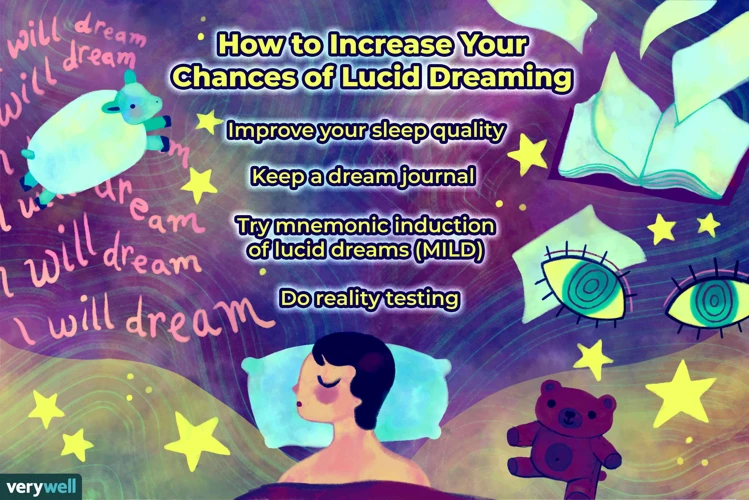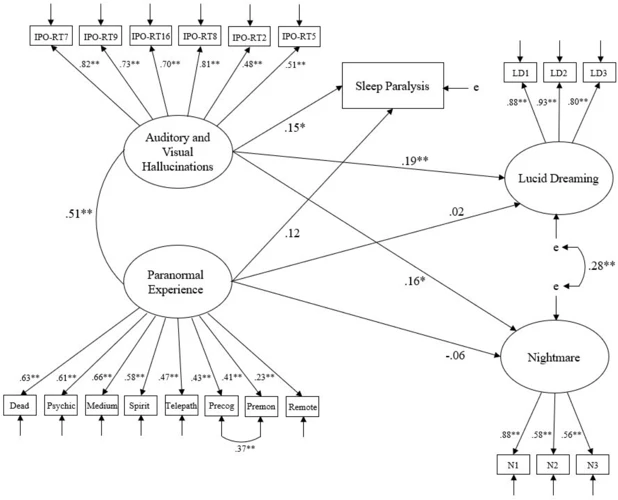Have you ever wondered what it would be like to control your dreams? Lucid dreaming allows you to do just that, giving you the ability to become aware and take control of your dreams while you sleep. However, there are many myths and misconceptions surrounding this fascinating phenomenon. In this article, we will debunk some of the most common myths about lucid dreaming, giving you a better understanding of what it really entails and how you can experience it for yourself. So, let’s dive into the world of lucid dreaming and separate fact from fiction!
Myth 1: Lucid Dreaming is Dangerous

There is a pervasive myth that lucid dreaming is a dangerous practice, but this couldn’t be further from the truth. While it is true that lucid dreaming involves a level of control and awareness within dream states, it does not pose any inherent risks or dangers. In fact, lucid dreaming can be a safe and enjoyable experience for most people. It allows individuals to explore their creativity, problem-solving skills, and even tap into spiritual dimensions. Lucid dreaming can even be used as a tool for personal growth and self-development. Rather than being dangerous, lucid dreaming offers a world of possibilities and can be a fascinating and empowering experience. So, put aside any concerns about its safety and embrace the incredible potential of lucid dreaming. To learn more about using lucid dreams for problem-solving and creative inspiration, click here.
Explanation of the myth
The myth that lucid dreaming is dangerous stems from the misconception that by becoming aware and taking control of one’s dreams, it may lead to negative consequences or interfere with waking life. Some people may worry that lucid dreaming could blur the line between reality and dreams, causing confusion or even a loss of touch with reality. However, it is important to understand that lucid dreaming occurs within the realm of sleep and dreams, and it does not have any harmful effects on one’s waking life or mental well-being. In fact, lucid dreaming can offer numerous benefits such as enhanced creativity, problem-solving abilities, and personal growth. It allows individuals to explore their inner world and gain insights that can be applied to their waking life. Lucid dreaming is a natural phenomenon that can be experienced by anyone with practice and techniques. It is a safe and enriching experience that can be enjoyed responsibly. To learn more about the benefits of lucid dreaming and how it can be used for problem-solving and creative inspiration, click here.
Debunking the myth
Debunking the myth that lucid dreaming is dangerous is essential to understanding and appreciating this unique experience. Firstly, it is important to note that lucid dreaming occurs during the REM (Rapid Eye Movement) stage of sleep, which is a natural and normal part of the sleep cycle. This means that lucid dreaming is a naturally occurring phenomenon and not something to be feared.
Many concerns about the dangers of lucid dreaming stem from misconceptions and misunderstandings. People may worry that they can become “stuck” in a lucid dream or that they will be unable to wake up. However, it is worth noting that lucid dreamers have the ability to control their dreams, including waking themselves up if desired.
Another concern is the potential for lucid dreaming to blur the boundaries between dreams and reality. While lucid dreams can feel incredibly vivid and lifelike, it is important to remember that they are still dreams and not actual waking experiences. Lucid dreamers can distinguish between dream and reality.
Additionally, some individuals worry that lucid dreaming can lead to psychological or emotional imbalances. However, research has not found any evidence of negative psychological effects from lucid dreaming. In fact, many people find that lucid dreaming enhances their well-being, creativity, and problem-solving skills.
To further debunk the myth, it is important to highlight the extensive research and literature surrounding lucid dreaming. Studies have demonstrated the potential benefits of lucid dreaming, such as improving sleep quality, reducing nightmares, and even facilitating personal growth and spiritual exploration.
Debunking the myth that lucid dreaming is dangerous is crucial for understanding its true nature. Lucid dreaming is a safe and natural phenomenon that offers incredible opportunities for self-discovery, creativity, and personal development. By embracing lucid dreaming, individuals can unlock the limitless potential of their dreams. To learn more about using lucid dreams for problem-solving and creative inspiration, click here.
Myth 2: Lucid Dreaming Requires Special Skills

One of the most common misconceptions about lucid dreaming is that it requires special skills that only a select few possess. This myth often leads people to believe that lucid dreaming is inaccessible or difficult to achieve. However, the truth is that anyone can learn to have lucid dreams with practice and patience. While some individuals may naturally experience lucid dreams more frequently, it is not an exclusive ability limited to a chosen few. There are various techniques and methods that can be learned to increase the likelihood of having lucid dreams, such as reality checks, dream journaling, and meditation. With consistent effort and a positive mindset, anyone can unlock the incredible world of lucid dreaming. To read about someone’s firsthand experience with lucid dreaming, click here.
Explanation of the myth
The myth that lucid dreaming is dangerous stems from a misunderstanding of the nature of dreams and the concept of conscious awareness within them. Some people believe that if you have too much control over your dreams, it can disrupt your sleep patterns or even lead to mental health issues. However, there is no scientific evidence to support these claims. Lucid dreaming occurs during the REM (rapid eye movement) stage of sleep, which is a normal and essential part of the sleep cycle. It is a natural phenomenon that has been studied and practiced for centuries without any documented negative effects.
One possible reason for this misconception is the confusion between lucid dreaming and sleep paralysis. Sleep paralysis is a phenomenon that occurs when a person wakes up from REM sleep but experiences temporary paralysis of the voluntary muscles. Sleep paralysis can be accompanied by vivid hallucinations and a feeling of pressure on the chest, which can be terrifying for those who experience it. However, sleep paralysis is not an inherent aspect of lucid dreaming, and not all lucid dreamers will experience it.
It is important to note that lucid dreaming is a skill that can be learned and practiced safely. Like any new skill, it may take time and effort to become proficient, but with patience and persistence, anyone can learn to lucid dream. There are various techniques and practices that can be used to increase the likelihood of having lucid dreams, such as reality checks, dream journaling, and meditation.
The myth that lucid dreaming is dangerous is based on misinformation and misunderstandings. Lucid dreaming is a natural and safe experience that can have numerous benefits, including personal growth, enhanced creativity, and problem-solving abilities. So, rest assured, exploring the world of lucid dreaming is a fascinating and rewarding journey that poses no inherent risks. To learn more about the benefits of lucid dreaming and how it can be used for problem-solving and creative inspiration, click here.
Debunking the myth
Debunking the myth that lucid dreaming is dangerous is essential to provide a clear understanding of this phenomenon. The truth is that lucid dreaming is a natural and harmless experience. It does not pose any physical or psychological risks when practiced responsibly. In fact, lucid dreaming has been studied extensively, and research has shown its numerous benefits. It can enhance creativity, problem-solving abilities, and even aid in personal growth and self-discovery. Some individuals have reported using lucid dreams as a platform for solving real-life problems and gaining valuable insights. Lucid dreaming also offers opportunities to explore spiritual dimensions and gain a deeper understanding of oneself. So, rather than being dangerous, lucid dreaming holds the potential for positive and transformative experiences. To learn more about using lucid dreams for problem-solving and creative inspiration, you can check out this article.
Myth 3: Lucid Dreaming is Rare and Difficult to Achieve

Many people believe that lucid dreaming is a rare and difficult phenomenon to achieve, but this is actually a myth. While it may take some practice and dedication, lucid dreaming is something that anyone can learn to do. It’s true that not everyone experiences lucid dreams naturally, but with the right techniques and mindset, anyone can increase their chances of having lucid dreams. There are various methods such as reality checks, dream journaling, and meditation that can help individuals become more aware in their dreams. It’s also important to note that the frequency of lucid dreaming can vary from person to person. While some individuals may have lucid dreams frequently, others may have them less often. The key is to be patient and persistent in your practice. So, don’t let the misconception of lucid dreaming being rare and difficult deter you from exploring this incredible phenomenon. To learn more about lucid dreaming and gain insights into others’ first experiences, click here.
Explanation of the myth
One of the main reasons why lucid dreaming is often perceived as dangerous is due to a lack of understanding and misinformation. Many people mistakenly believe that by becoming aware and exerting control over their dreams, they are interfering with the natural sleep process. They worry that it may lead to sleep disturbances or have negative effects on their mental and physical well-being. Additionally, some individuals associate lucid dreaming with the concept of “out-of-body experiences” or “astral projection,” which they view as dangerous or rooted in supernatural powers. These misconceptions can create fear and hesitation when it comes to exploring the world of lucid dreaming. However, it’s important to note that lucid dreaming is a natural phenomenon that occurs during the rapid eye movement (REM) stage of sleep and does not disrupt the overall sleep architecture. Research has shown that lucid dreaming can actually have numerous benefits, including enhancing problem-solving skills, boosting creativity, and offering a space for self-exploration and personal growth. It is a safe and enriching experience that can be enjoyed by individuals of all backgrounds and ages. So, don’t let the myth of danger deter you from delving into the extraordinary realm of lucid dreaming. To learn more about my personal experience with lucid dreaming, click here.
Debunking the myth
Debunking the myth that lucid dreaming is dangerous is essential to understanding the true nature of this remarkable practice. Numerous scientific studies have shown that lucid dreaming is a natural and safe phenomenon experienced by people across the globe. It is important to differentiate between lucid dreams and nightmares, as they are not the same thing. Nightmares can occur during both regular dreams and lucid dreams, but they do not pose a greater risk in lucid dreaming specifically. In fact, knowing that you are dreaming can empower you to confront and overcome any disturbing elements within a dream. Additionally, lucid dreaming does not have any negative physical or psychological effects on the body or mind. It is a natural process that occurs during rapid eye movement (REM) sleep, when the brain is highly active. Lucid dreaming provides a unique opportunity for self-exploration, personal growth, and even problem-solving. It can be a powerful tool for enhancing creativity and gaining inspiration. So, debunking the myth of the dangers associated with lucid dreaming opens up a world of possibilities for those interested in delving into the fascinating realm of lucid dreaming. To dive deeper into the exploration of spiritual dimensions in lucid dreaming, click here.
Myth 4: Lucid Dreaming Can Replace Real-Life Experiences

One common misconception about lucid dreaming is that it can replace real-life experiences. While lucid dreaming offers an incredible opportunity to explore and create within the dream world, it cannot fully substitute for the richness and depth of real-life experiences. Real-life experiences provide us with a multifaceted understanding of the world and allow us to engage with our senses, emotions, and physical bodies in unique ways. Lucid dreaming can be a complementary and enriching aspect of our lives, but it should not be relied upon as a complete replacement for real-life experiences. Embracing both our waking life and our dream life allows us to fully immerse ourselves in the wonders of our existence. If you’d like to learn more about a personal experience with lucid dreaming, check out this captivating account of a first-time lucid dreamer by clicking here.
Explanation of the myth
The myth that lucid dreaming is dangerous stems from a misunderstanding of the nature of dreams themselves. Dreams are a natural part of the sleep cycle and serve important functions in processing emotions, memories, and experiences. Lucid dreaming simply adds an element of awareness and control to these dreams. Some people may worry that lucid dreaming can lead to negative experiences or have adverse effects on mental well-being. However, research has shown that lucid dreaming is generally a positive and safe practice. It allows individuals to overcome fears, explore their creativity, and gain insight into their subconscious mind. While it is possible to experience intense emotions or vivid scenarios in a lucid dream, these occurrences are no different from regular dreams. Like any other activity, lucid dreaming should be approached with a responsible and balanced mindset. Understanding the potential benefits and taking proper care of one’s sleep hygiene can help ensure a positive experience. To learn more about lucid dreaming and its potential for problem-solving and creative inspiration, click here.
Debunking the myth
Debunking the myth that lucid dreaming is dangerous is essential to understanding the realities of this practice. Numerous scientific studies and anecdotal evidence have shown that lucid dreaming is generally safe and can even have positive effects on mental well-being. The idea that lucid dreaming can lead to physical harm or cause psychological issues is unfounded. In fact, lucid dreaming is a natural phenomenon that occurs during the REM (rapid eye movement) stage of sleep, and it is simply a heightened state of awareness within the dream. Unlike sleepwalking or other parasomnias, lucid dreaming does not involve any physical movement or behaviors that could pose a danger. It is a voluntary and conscious experience that can be ended at any time by waking up. Some people also worry about the potential for confusion between dream and reality, but studies have shown that lucid dreamers are generally able to distinguish between the two states. In terms of mental well-being, research has suggested that lucid dreaming can have therapeutic benefits, such as reducing nightmares and improving problem-solving skills. It can also offer opportunities for personal exploration and self-discovery, as well as the ability to overcome fears and practice skills in a safe dream environment. The notion that lucid dreaming is dangerous is nothing more than a myth. To learn more about the enriching aspects of lucid dreaming, you can read about exploring spiritual dimensions in lucid dreaming.
Myth 5: Lucid Dreaming Leads to Sleep Paralysis

One common myth surrounding lucid dreaming is that it leads to sleep paralysis. Sleep paralysis is a temporary inability to move or speak while transitioning between sleep and wakefulness, and it can be a frightening experience. However, it is important to note that lucid dreaming itself does not directly cause sleep paralysis. Sleep paralysis is a natural phenomenon that can occur independently of lucid dreaming. In fact, lucid dreaming can provide individuals with a greater sense of control and reduce the likelihood of experiencing sleep paralysis. While sleep paralysis can be unsettling, understanding the phenomenon and practicing good sleep hygiene can help minimize its occurrence. So, rest assured that lucid dreaming can be a safe and enjoyable experience without the risk of sleep paralysis. To learn more about the transformative potential of lucid dreaming, click here.
Explanation of the myth
The belief that lucid dreaming is dangerous stems from various misconceptions and misunderstandings surrounding this phenomenon. One common misconception is that lucid dreaming can lead to a loss of touch with reality. However, the reality is that lucid dreaming occurs during the REM (Rapid Eye Movement) stage of sleep, which is a natural and essential part of the sleep cycle. Lucid dreaming does not blur the lines between dreams and reality; instead, it offers a heightened sense of awareness within the dream state.
Another misconception is that lucid dreaming can result in physical harm. This fear may arise from vivid dreams where individuals find themselves in challenging or risky situations. However, lucid dreamers have the ability to control their dreams and can choose to avoid or change any perceived danger. Lucid dreaming actually provides a safe environment to explore and confront fears, as it is a construct of the mind and not an actual physical experience.
Some people also believe that lucid dreaming can lead to sleep disturbances or insomnia. However, studies have shown that lucid dreaming can actually improve the overall quality of sleep. Lucid dreamers tend to have better sleep patterns and report higher levels of satisfaction with their sleep. Lucid dreaming can even be a useful tool for managing nightmares and recurring dreams. For more information on the benefits of lucid dreaming, you can read about a personal first-hand experience here.
The notion that lucid dreaming is dangerous is unfounded. It is a natural and safe experience that offers individuals the opportunity to explore the boundless possibilities of their dreams. Now that we have debunked this myth, let’s dive deeper into the world of lucid dreaming and uncover more truths about this extraordinary phenomenon.
Debunking the myth
Debunking the myth that lucid dreaming is dangerous is essential in understanding the reality of this practice. Numerous scientific studies and firsthand experiences have shown that lucid dreaming carries no inherent risks to physical or mental health. In fact, lucid dreaming can be a positive and enriching experience. During lucid dreams, individuals have the ability to explore their subconscious mind, confront fears, and even engage in problem-solving and creative inspiration. It is important to note that lucid dreaming occurs during REM sleep, which is a natural and essential part of the sleep cycle. Lucid dreaming does not disrupt the normal sleep pattern or interfere with the quality of rest. While it is essential to approach lucid dreaming with knowledge and awareness, there is no basis for the fear surrounding its safety. By understanding the techniques and practices involved in lucid dreaming, individuals can harness its potential for personal growth and self-exploration without any harm. To learn more about how lucid dreaming can be used for problem-solving and creative inspiration, click here.
Myth 6: Lucid Dreaming is Time-Wasting

Many people believe that lucid dreaming is a waste of time, but this myth fails to recognize the numerous benefits and potential for personal growth that comes with the practice. Engaging in lucid dreaming allows individuals to tap into their subconscious mind, explore their inner creativity, and even gain problem-solving insights that can be applied to real-life situations. Lucid dreaming can be a time well-spent, as it offers a unique opportunity to experience things that may not be possible in the waking world. By taking the time to develop and cultivate lucid dreaming skills, individuals can open themselves up to a world of self-discovery and exploration. So, don’t fall for the misconception that lucid dreaming is a waste of time. Embrace the potential that lucid dreaming holds and start using it as a tool for problem-solving and creative inspiration. To learn more about how lucid dreaming can be used for problem-solving and creative inspiration, check out this resource.
Explanation of the myth
One common misconception about lucid dreaming is that it is a dangerous practice. This myth may stem from the fear of the unknown or the belief that tampering with dreams can have negative consequences. However, the truth is that lucid dreaming is a natural and safe phenomenon. When we dream, our brain enters a state of REM (rapid eye movement) sleep, where vivid and lifelike dreams occur. Lucid dreaming simply means becoming aware that you are dreaming while in this REM state. It does not involve any physical harm or pose a risk to mental health. Lucid dreaming is a skill that can be developed and practiced, just like any other skill. It does not lead to any physiological or psychological harm. In fact, numerous studies have shown that lucid dreaming can have positive effects on well-being, creativity, and problem-solving abilities. So, rather than being dangerous, lucid dreaming is a fascinating and rewarding experience that can open up new possibilities and enhance your understanding of the dream world. To learn more about exploring the spiritual dimensions of lucid dreaming, click here.
Debunking the myth
Debunking the myth that lucid dreaming is dangerous is essential in order to dispel any unnecessary fears associated with this practice. Scientific research has consistently shown that lucid dreaming is a normal and natural part of the sleep cycle, and it does not pose any physical or psychological harm. Lucid dreaming occurs during the REM (Rapid Eye Movement) stage of sleep, which is a normal and necessary stage for healthy sleep patterns. People who experience lucid dreams are simply more aware of their dreams and have the ability to control certain aspects of them. There is no evidence to suggest that lucid dreaming leads to any negative repercussions or adverse effects on mental health. In fact, lucid dreaming can have numerous positive benefits, such as enhancing self-awareness, improving problem-solving skills, and providing creative inspiration. By exploring the different dimensions of lucid dreaming, individuals can tap into their subconscious mind and gain valuable insights and experiences. To learn more about the spiritual dimensions of lucid dreaming, click here.
Myth 7: Lucid Dreaming Can Cause Insomnia

There is a common misconception that lucid dreaming can cause insomnia, but this is not necessarily the case. While it is true that some individuals may experience difficulty sleeping or disruptions in their sleep patterns when actively practicing lucid dreaming, this is often due to improper techniques or excessive excitement rather than the practice itself. In fact, lucid dreaming can actually promote better sleep by fostering a sense of relaxation and control within the dream state. By incorporating relaxation techniques, maintaining a consistent sleep schedule, and practicing good sleep hygiene, individuals can enjoy the benefits of lucid dreaming without compromising their overall sleep quality. To learn more about the potential of lucid dreaming in problem-solving and creative inspiration, click here.
Explanation of the myth
The myth that lucid dreaming is dangerous stems from misconceptions and misunderstandings about the nature of dreams and the practice of lucid dreaming itself. Some people believe that by gaining control over their dreams, they may be inadvertently tampering with their subconscious mind or accessing dangerous realms. These concerns are often fueled by the fear of the unknown and a lack of understanding about the psychological and physiological aspects of dreams. However, scientific research has consistently shown that lucid dreaming is a natural and normal part of the sleep cycle. When we dream, our brains are highly active, and lucidity simply means becoming aware that we are dreaming. It is not associated with any physical or psychological harm. In fact, lucid dreaming can have numerous benefits, such as improving problem-solving skills and providing creative inspiration. By debunking the myth that lucid dreaming is dangerous, individuals can feel more confident in exploring this fascinating and enriching practice. To learn more about how lucid dreaming can be used for problem-solving and creative inspiration, click here.
Debunking the myth
Debunking the myth that lucid dreaming is dangerous requires us to examine the evidence and scientific research surrounding this practice. Numerous studies have been conducted on lucid dreaming, and they consistently show that lucid dreaming is a natural and safe phenomenon experienced by many individuals. While it is true that some people may have disorienting experiences or encounter nightmares during the initial stages of learning lucid dreaming, these difficulties are temporary and can be overcome with proper techniques and guidance.
One common concern is the idea that lucid dreaming may lead to confusion between dreams and reality. However, research has shown that the human brain possesses the ability to distinguish between dream states and waking reality. Lucid dreamers are fully aware that they are in a dream and can control their actions within the dream without any confusion.
Another misconception surrounding the safety of lucid dreaming relates to the physical body. Some worry that attempting to take control in their dream may lead to sleepwalking or other forms of physical activity. However, the body remains in a state of paralysis during REM sleep, preventing any physical movements. Lucid dreamers can enjoy exploring their dreams without the risk of sleepwalking or disturbing their physical body.
Lucid dreaming has been found to have a range of positive effects on individuals. It can enhance creativity, problem-solving skills, and even spiritual exploration. Many people use lucid dreams as a source of inspiration for artistic endeavors or to gain deeper insights into their own psyche. Research even suggests that lucid dreaming can be utilized for personal growth, self-improvement, and therapy.
Debunking the myth that lucid dreaming is dangerous is crucial for understanding and embracing this incredible experience. With proper techniques and guidance, individuals can enjoy the benefits of lucid dreaming while ensuring their safety and well-being. To learn more about the potential uses of lucid dreams for problem-solving and creative inspiration, click here.
Myth 8: Lucid Dreaming is Only for the Giften Few
One common myth surrounding lucid dreaming is that it is only accessible to a select few individuals, often considered “gifted” in this realm. However, this belief couldn’t be further from the truth. Lucid dreaming is a skill that anyone can learn and develop with practice and patience. While some individuals may have a natural inclination towards lucid dreaming, it is not an exclusive ability reserved for a chosen few. Just like any other skill or practice, it requires dedication and understanding to master lucid dreaming techniques. There are various methods and techniques available to help individuals increase their likelihood of experiencing lucid dreams, such as reality checks, keeping a dream journal, and practicing visualization exercises. So, don’t let the misconception of lucid dreaming being limited to a select group discourage you from exploring this extraordinary practice. Embrace the possibility that lucid dreaming is accessible to everyone, and start your journey today. For more information on exploring the spiritual dimensions of lucid dreaming, click here.
Explanation of the myth
There are several misconceptions regarding the safety of lucid dreaming, leading to the myth that lucid dreaming is dangerous. One reason for this misconception is the association of lucid dreaming with nightmares or sleep disorders such as sleep paralysis. However, it is important to note that nightmares and sleep paralysis can occur during regular dreaming as well and are not exclusive to lucid dreaming experiences. In fact, lucid dreaming can actually help individuals overcome nightmares and gain control over their dreams to create more positive and fulfilling experiences. Another concern is the fear that lucid dreaming can blur the line between reality and dreams, leading to confusion or difficulty distinguishing between the two. However, lucid dreamers are fully aware that they are in a dream state and can consciously differentiate between dreams and reality. Additionally, some individuals worry that lucid dreaming can negatively impact sleep quality or disrupt natural sleep patterns. While it is true that lucid dreaming can occur during REM sleep, the same stage of sleep associated with dreaming, there is no evidence to suggest that lucid dreaming leads to sleep deprivation or other negative effects on sleep. In fact, lucid dreaming can enhance the overall quality of sleep by promoting feelings of relaxation and self-awareness. It is clear that the myth that lucid dreaming is dangerous is unfounded and does not accurately represent the reality of this incredible phenomenon. To learn more about the benefits of lucid dreaming and how it can be used for problem-solving and creative inspiration, click here.
Debunking the myth
To debunk the myth that lucid dreaming is dangerous, it’s important to understand that lucid dreaming is a natural and normal occurrence. It is a skill that can be learned and practiced by anyone. The idea that lucid dreaming is dangerous may stem from misconceptions or misunderstandings about the nature of dreams themselves. Dreams are a product of our subconscious mind and serve as a way for our brain to process emotions, memories, and experiences. Lucid dreaming simply adds an element of awareness and control to this natural process.
Scientific research has shown that lucid dreaming is generally safe and does not pose any physical or psychological harm. In fact, lucid dreaming can have numerous benefits. It can be a tool for personal growth, as one can explore and address personal issues within the safe confines of a dream. Lucid dreaming can also be a source of creativity and inspiration. Many artists, writers, and musicians have reported using lucid dreams as a source of inspiration for their work. So, rather than being dangerous, lucid dreaming is a fascinating and empowering practice that can enhance various aspects of one’s life.
It’s worth noting that lucid dreaming can be learned and practiced by anyone, regardless of their previous experience or expertise. There are techniques and exercises that can help individuals improve their lucid dreaming skills, such as reality checks, dream journaling, and meditation. By incorporating these practices into your daily routine, you can increase your chances of experiencing lucid dreams and reaping the benefits they offer.
Conclusion
The common myths and misconceptions surrounding lucid dreaming have been debunked, shedding light on its true nature and potential. Lucid dreaming is not dangerous, but rather a safe and empowering experience that allows individuals to take control of their dreams. It does not require any special skills, as anyone can learn to lucid dream with practice and techniques. Contrary to popular belief, lucid dreaming is not rare or difficult to achieve. While it may take time and effort, anyone can learn to have lucid dreams with the right approach. Lucid dreaming is not a replacement for real-life experiences, but rather a complementary and enriching practice that can enhance self-awareness and personal growth. Sleep paralysis is not inherently tied to lucid dreaming and can be managed through proper sleep hygiene practices. Lucid dreaming is not a waste of time, but rather a valuable tool for creativity, problem-solving, and exploration. It does not cause insomnia, but rather promotes better sleep quality when practiced in a balanced manner. Finally, lucid dreaming is not exclusive to a select few, but a skill that can be learned and developed by anyone interested in exploring the realms of their subconscious mind. So, don’t let these myths hold you back from delving into the incredible world of lucid dreaming and all it has to offer. Start your journey towards lucid dreaming today and unlock the limitless possibilities within your dreams. To learn more about using lucid dreams for problem-solving and creative inspiration, click here.
Frequently Asked Questions
FAQ 1: Can anyone learn to lucid dream?
Yes, absolutely! Lucid dreaming is a skill that can be learned and developed by anyone willing to put in the effort and practice. While some individuals may naturally have more frequent or vivid lucid dreams, anyone can learn techniques and strategies to increase their chances of experiencing lucid dreams.
FAQ 2: How do I start lucid dreaming?
A great starting point is to keep a dream journal. By recording your dreams upon waking, you become more aware of them, making it easier to recognize dream patterns and eventually become lucid. Additionally, practicing reality checks throughout the day, such as looking at your hands or checking the time, can help train your mind to question reality and increase your chances of having a lucid dream.
FAQ 3: Is lucid dreaming the same as astral projection?
No, lucid dreaming and astral projection are two distinct experiences. Lucid dreaming involves becoming aware and in control within a dream state, while astral projection is believed by some to involve the separation of consciousness from the physical body. While some elements may overlap, they are considered separate phenomena by most researchers and practitioners.
FAQ 4: Can lucid dreaming be used for problem-solving?
Absolutely! Lucid dreaming can be a powerful tool for problem-solving and creative inspiration. In a lucid dream, you can consciously explore different scenarios, experiment with solutions, and even gain new perspectives on real-life challenges. Many individuals have reported finding innovative solutions or gaining insights into their waking life problems through lucid dreaming.
FAQ 5: Is lucid dreaming a form of escapism?
No, lucid dreaming is not inherently a form of escapism. While it is true that lucid dreaming can provide a temporary escape from reality, it can also be a source of personal growth, self-exploration, and self-development. Lucid dreaming can be utilized for various purposes, including creative expression, learning, and spiritual exploration, making it a versatile and beneficial practice.
FAQ 6: Can lucid dreaming improve sleep quality?
Lucid dreaming itself is not directly linked to improving sleep quality. However, by practicing techniques to achieve lucidity, such as maintaining a dream journal and incorporating reality checks, individuals often develop better sleep habits and a heightened awareness of their dreams. This increased awareness of one’s dream state can contribute to an overall improved sleep experience.
FAQ 7: Does lucid dreaming have any physical benefits?
While the primary benefits of lucid dreaming are often psychological and experiential, some studies suggest that lucid dreaming practice may have indirect physical benefits. These can include reduced nightmares, increased relaxation, and improved overall well-being. Further research is still needed to fully understand the potential physical benefits of lucid dreaming.
FAQ 8: Can lucid dreaming be used for spiritual exploration?
Yes, lucid dreaming can be a powerful tool for exploring spiritual dimensions and experiences. Some individuals use lucid dreaming to connect with their inner selves, explore subconscious beliefs, or even engage with spiritual guides. Lucid dreams can provide a unique platform for spiritual growth and self-discovery.
FAQ 9: Are there any risks associated with lucid dreaming?
Generally, lucid dreaming is considered safe for most individuals. However, it is essential to prioritize your well-being and practice healthy sleep habits. Some individuals may experience sleep disturbances or increased sleep disruptions when actively trying to induce lucid dreaming. It is always recommended to consult with a healthcare professional if you have any concerns about the impact of lucid dreaming on your overall sleep health.
FAQ 10: How long does it take to have a lucid dream?
The timeframe for achieving a lucid dream varies from person to person. Some individuals may experience their first lucid dream soon after practicing certain techniques, while for others, it may take more time and patience. Consistency, experimentation, and perseverance are key when it comes to increasing the likelihood of having lucid dreams.








